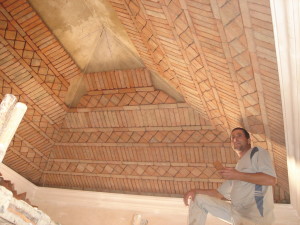
Screed settlement does not have to be different from the one used to screed the settlement of other ceramic floors, except the Santa Catarina tiles, that usually have a greater thickness (about 2 cm).
Today our tile is laid with adhesive tile, leaving a joint that varies between 1-2cm, which depends on the customer’s taste and can later be filled with a mass appropriate for joints or simply with cement mortar and sand. After finishing laying and grouting, the final finish depends largely on the customer’s wish and the part of the house where the tile is set. After a good cleaning, always trying to avoid the maximum use of harsh chemicals, the tiles can keep their natural appearance, without any finishing. The terracotta manual, even without treatment, is prepared to withstand different weather conditions and the normal use for this type of product, which is handmade. Despite this, and because this type of tile is porous, like stone and other unglazed ceramic materials, it can absorb water as well as other undesirable products such as oils and fats that can be poured over them. If you are in a place where there is a risk of contact with these products which are likely to cause stains, you can apply a sealer with the goal of plugging the pores and prevent this problem. It can also be used in an interior acrylic wax or varnish to sharpen or brighten the tile, if you want a higher contrast.
Because we want our material to be applied and treated the best way, and with the aim of preventing and helping our customers, here are a few precautions to take in the implementation and management of terracotta manual:
- The placement of the tile or any other piece of terracotta and the application of treatment products should only be made at least one month after the execution of betomilhas.
- products for treatment should not be applied at temperatures below +5°C and if it rains or there is too much humidity in the air, you should wait for drier weather so that the pavement can dry completely. It should not also be applied to very hot surfaces or surfaces that have been directly exposed to the sun in peak hours.
- Do not store the products for treatment at temperatures below 0°C. The storage period should not be longer than indicated by the manufacturer (usually 1 to 2 years).
- Products for treatment should be well shaken before application. 5) Right before the application of these products it is essential that the terracotta is clean, dry (24 to 36 hours at 20º C) and free from contaminants such as oil, grease or the remains of cement. If this doesn’t happen, the pores that are filled
- with water or another product, will not allow the penetration of the waterproofing layer, thus making the layer so thin that it can come loose easily after some time.
- The application of any chemical product near the surface, including fertilizers and other fertilizers used in nearby gardens, can also be a negative aspect.
The general indications described here were collected from technicians of several manufacturer companies or their representatives and should be followed by the technical information specific to each product, supplied by the manufacturer and / or representative.

